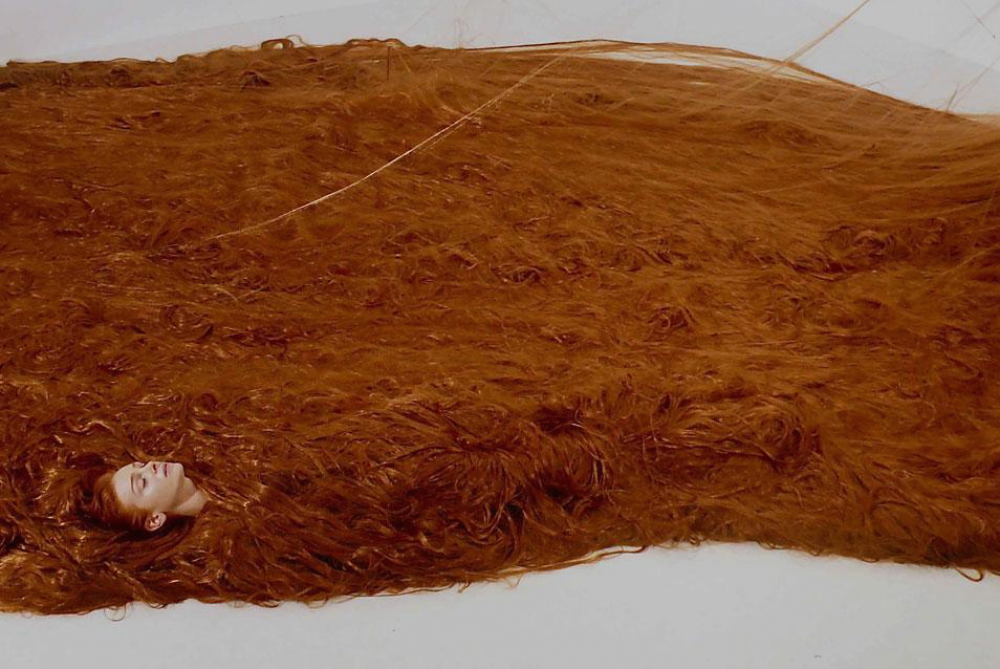For Copper Queens and Kings
With a different "(De)Tangled" perspective, Morgan Cattaneo offers her very own triumphant ode to redheads.

Photograph from a 2008 performance by Alice Anderson at the National Museum Marc Chagall, Nice. Courtesy Riflemaker, London.
Lilith, the original temptress, was a redhead. That infamous icon of man-eaters and embodiment of the evil seductress first appears in the Epic of Gilgamesh, a text that predates Judeo-Christianity by about a thousand years. The goddess-demon, a femme fatale who preys on the blood of children and ravishes men whilst brandishing locks that are—according to the Encyclopedia of Jewish Folklore and Traditions—“as long and red as the rose,” an ornament “for the seduction of the son of man.” While Lilith was born of the same ashes as Adam, as his equal, and deserted the Garden of Eden on her own free will (after an unwelcome sexual advance, mind you) to take refuge (and presumably conduct all manner of witchcraft and evil) at the Dead Sea, Eve, as we know, was created from the rib of Adam, almost as an afterthought. Lilith’s successor, the “pure” and subservient Eve, as depicted in Michelangelo's two-part fresco The Temptation and Expulsion of Adam and Eve only earns her copper curls after her fall from grace. Both Judas Iscariot and Mary Magdalene, the European Christian originators of betrayal and harlotry respectively, have been portrayed as redheads. It’s no secret that being a redhead suggests an innate identity, arguably more so than any other hue of hair. Redheads today are known worldwide as being acutely temperamental, mean-spirited, “fiery”— as wearing the mark of beastly sexual desire and moral degeneration.
It should be said that these sweeping generalizations pertain almost exclusively to women. In a 1998 GQ article, Tom Robbins, one of the forefathers of the contemporary redhead fetishization, stated in atypically simple fashion, “Red hair is a woman’s game.” And Playboy, the magazine synonymous with the sexualized representation of women, particularly blonde women, said, “Redheads are like other women—only more so.” Obviously the role of sexual deviant does not apply to men, historically, as they have been granted patriarchal reign, both on and off the sexual field. But why are redheaded women revered as archetypes of seduction, strength, and hot-headedness while redheaded men are regarded as conventionally unattractive and unappealing? Yes, as gender roles and binaries begin to shift for the better, this cliché is breaking down, as proven by the bi-monthly gay male party, the aptly named Fire in the Hole, which exists as “New York City’s only monthly party for gingers and those who love them.” However, a walk down the Renaissance hall of any major museum is enough to make even the most innocent of cheeks blush with ruby desire. Botticelli alone created enough auburn-haired beauties to cement the redhead as the ideal representation of female sex, love, desire, and passion. It’s the duality of the redhead—her ability to represent both lust and love, pleasure and violence, danger and comfort—that is (again stated by Robbins) “virtually irresistible to the male of the species.”
Now, this kind of hetero-normative, biblical-based attraction is obviously problematic in today’s society, albeit less so than it was throughout the fifteenth and seventeenth centuries when approximately 45,000 redheaded women were tortured and murdered on account of witchcraft. Yet despite our hardships and mischaracterizations, from 1920s “It Girl” Clara Bow to Mad Men’s Joan Holloway (Christina Hendricks), cardinal-tressed leading ladies have continued to exude confidence, sex appeal, desire, and independence. It’s the culturally forbidden female combination of innocence and transgression which leaves us wanting. Would Lindsay Lohan have had as long of a run as she did otherwise?
As a woman who possesses the rare MC1R protein, (or melanocortin 1 receptor, the recessive trait possessed by an estimated one to two percent of the world’s population) there is a reverent obligation that comes with the identity. Though I weathered many of the unsavory childhood nicknames (and my grandmother’s relentless push to become an Irish stepdancer), my red hair is as much a part of my identity as my temper (short), my libido (insatiable), or my SPF preference (60+). It is—and has been—my experience as a genetic freak that sets me apart, whether it was being called Big Red as an abnormally tall, abnormally flame-topped adolescent, or enduring the trite pick-up lines drunkenly muttered by that guy who has “always had a thing for redheads.” We’re not for everyone, particularly not the faint of heart, as any of my many exes will affirm, but we daughters of Venus, we star-mapped agents of the Harvest Moon, have surely secured our place in history. May we forever color the world with blood oranges and holy pomegranate juice. May the coral sirens of the sea continue to coax sailors from ships, may the flushed cherry bombs continue to set the world on fire. We descendents of Lilith, though easily patined, may we always reign as Copper Queens and Kings.
Editor's Note
This piece was originally published under the name Lamb Lee.



